No One Says “No” to Chindian Food

By Asavari Singh
Contributor
30/6/2021
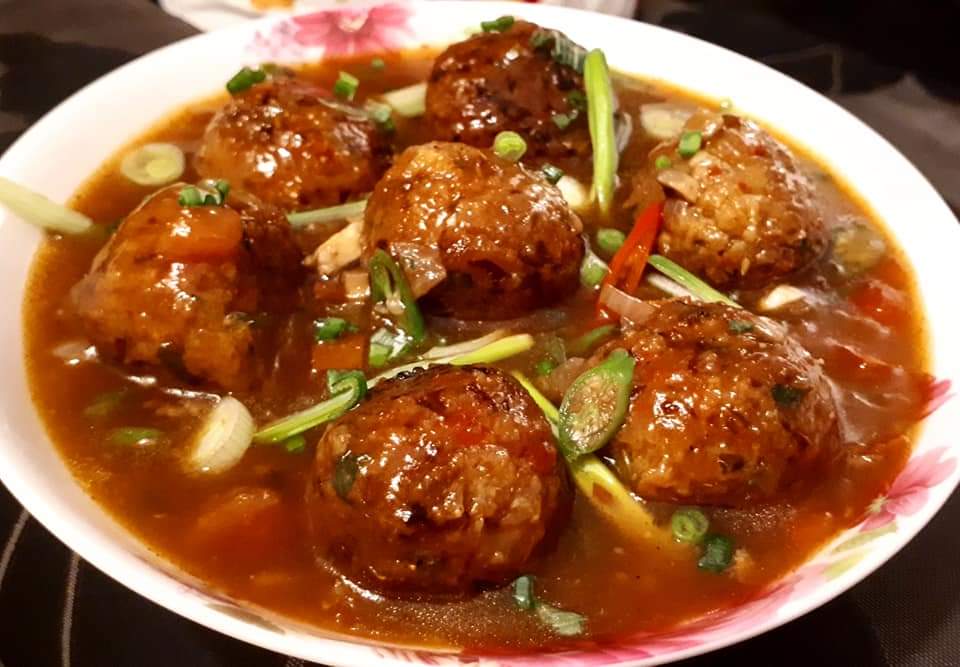
Veg Manchurian, a “Chindian” dish of batter-fried vegetable balls swimming in a gravy of tomato ketchup, soy, and chilli sauce, and garnished with diced green onions and fresh chillies (Picture Credit: Anamika Bajpai)
When Chinese troops killed 20 Indian soldiers in a border conflict last summer, it sparked outrage across India. The Indian government retaliated by banning more than 200 Chinese apps (including the immensely popular TikTok). Ordinary citizens also played their part. A few families hurled Made in China tv sets from their balconies, some shopkeepers burned their Chinese-made stock, and many people compiled and shared detailed lists on social media of imported goods from China to boycott.
However, when the Indian minister for social justice, Ramdas Athawale, suggested that Indians should also immediately boycott Chinese restaurants and food, no one was particularly fired up. A handful of “patriots” did dutifully picket their neighborhood noodle joints, but most Indians pushed back — not because of the inherent stupidity of banning a cuisine, but because they were aghast at the idea that Chinese food in India could be linked in any way with China. A leading liberal Indian journalist, Vikram Chandra, immediately tweeted what the majority of Indians felt about the politician’s call to action: “[M]ost of what is called ‘Chinese’ food in India is actually ‘Indian Chinese’ (and is, IMHO, tastier than the original). In nearly all cases, it is made in India, by Indians, and from Indian grain/vegetables/chicken.”
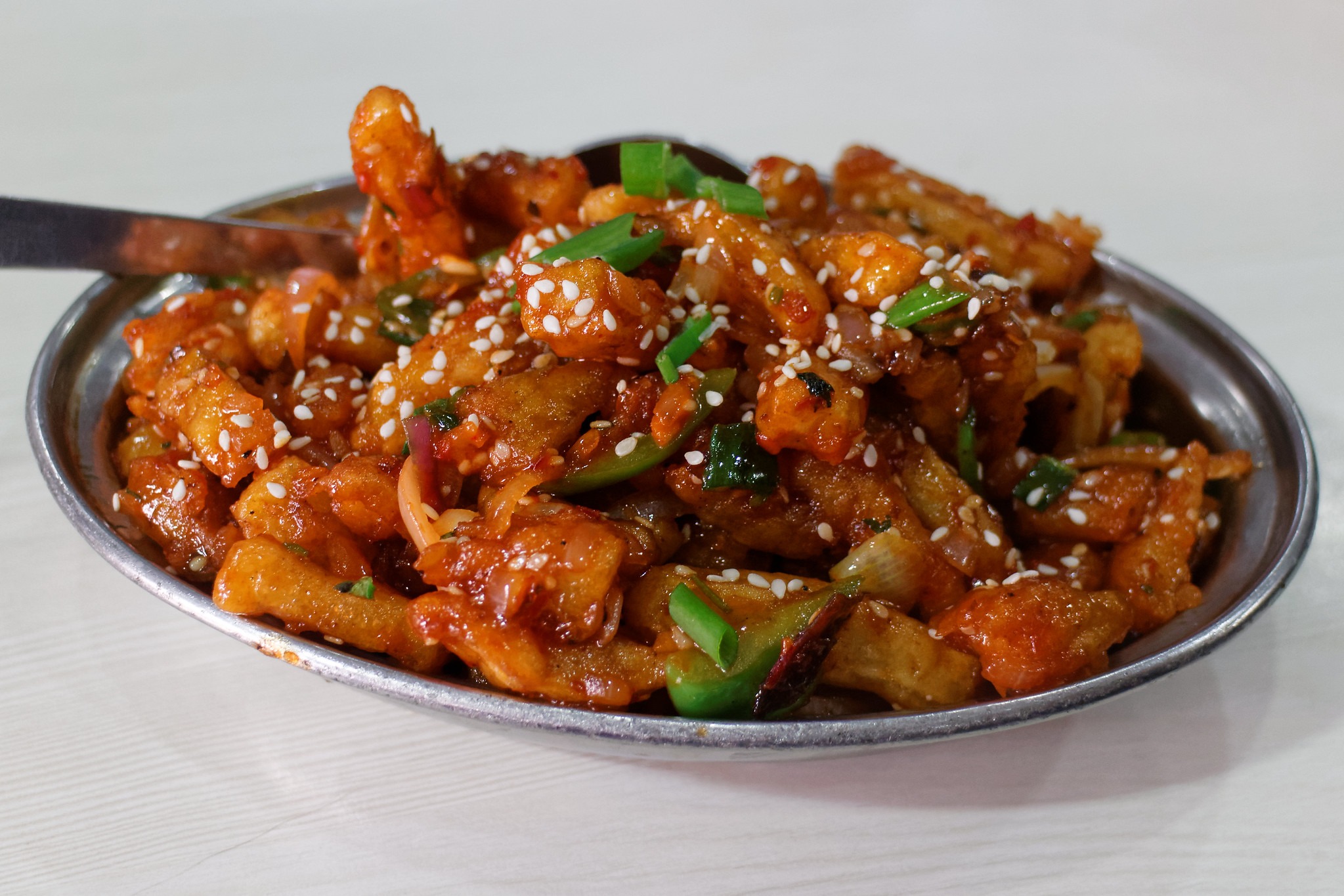
Honey-chili potatoes are a beloved snack. They are essentially French fries coated in a chili-laden batter and then dunked in a sticky sauce of honey, chili sauce, and soy. A garnish of spring onions and toasted sesame seeds completes the dish. (Picture Credit: Nadir Hashmi)
Mostly, he was right. The average Chinese person would likely be aghast at what might pass for a Sichuan or Hakka dish in India. “Indian Chinese” is indeed its own kind of hybrid cuisine. The boundaries have blurred so much, in fact, that it is often referred to as “Chindian” food. Moreover, in the last year or so in the wake of COVID and Chinese border incursions, this fusion cuisine has become an important site of “banal nationalism,” a term coined by the social psychologist Michael Billig to describe the “continual ‘flagging,’ or reminding, of nationhood” in everyday life. More than ever, Chindian cuisine is defiantly branded and promoted as solely Indian, as “ours” and not “theirs” — whether it is via social media posts (for instance, I recently saw a Facebook post in which a Chindian meal was artfully arranged to represent the colours of the Indian flag) or in the media, where a sense of ownership over the cuisine is frequently expressed, like in this article criticizing the ban: “[T]here’s nothing foreign about Chinese food in India anymore. Chinese food has long become atmanirbhar [self-reliant] in India. It needs no parts from China, unlike our mobile phones and laptops.” Another aspect of this banal (but not necessarily “benign,” as Billig reminds us in his book) nationalism is the repeated portrayal in popular discourse of “real” Chinese food as “bland,” “inedible,” and “dirty” because of its use of meats that are not typically eaten in India. The narrative is that India took in an inferior cuisine and transformed it into something purer and better, thus feeding not only hungry stomachs but nationalist fantasies about cultural superiority.
The narrative is that India took in an inferior cuisine and transformed it into something purer and better.
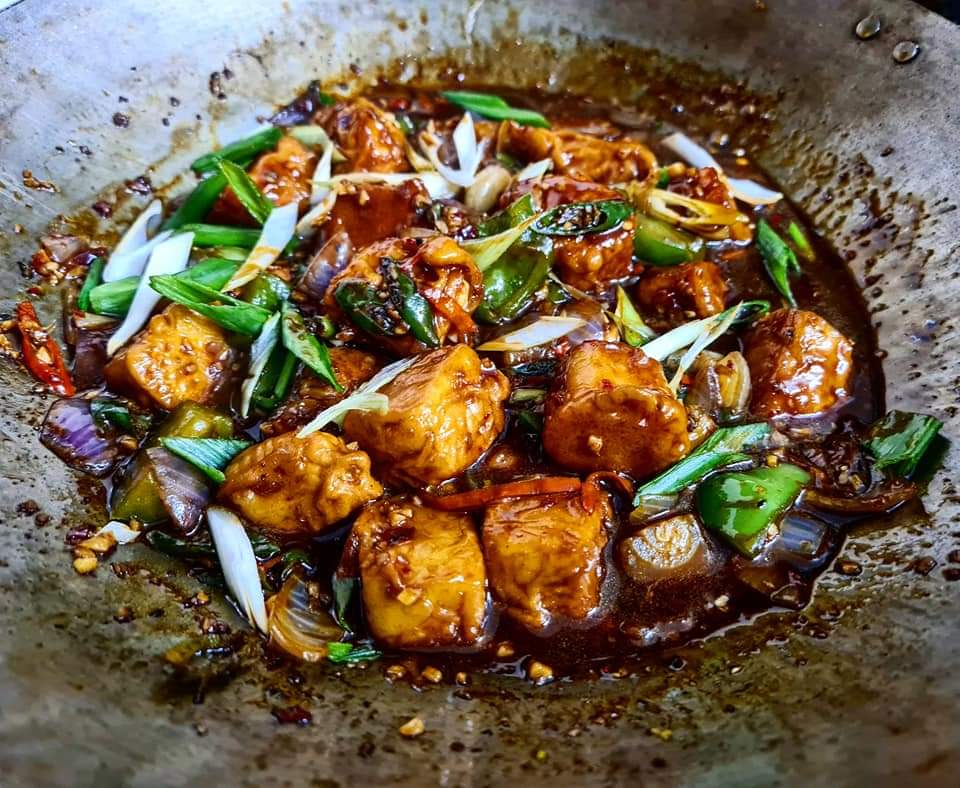
Chilli paneer (cottage cheese) with a glutinous soy gravy (Picture Credit: Anamika Bajpai)
However, not so long ago, this unique cuisine truly was seen as Indo-Chinese and acknowledged as such. It was indeed always made in India, with Indian ingredients, and for Indian tastes, but it originated from Chinese immigrants and their descendants.
The first Chinese settlers arrived on the shores of Bengal in the late 1700s to work as laborers or in the opium and tea trades. Many made Calcutta (now known as Kolkata) their home, where the community went on to exert a social, cultural, and economic influence disproportionate to their numbers. The Hakka established successful tanneries and shoe businesses, the families from Hubei became known for their dentistry, the Cantonese distinguished themselves as carpenters. Even today, Calcutta’s Tiretti Bazaar and Tangra neighborhood are referred to as the old and new Chinatowns respectively, but they are nowhere near as “Chinese” as they used to be.
After a border war broke out between India and China in 1962, the Indian-Chinese residents of Calcutta — most of whom had never known any other home and had nothing to do with the war — lived in dread of midnight knocks on their doors. Many, including children, were rounded up and dispatched to a detention camp in the arid desert state of Rajasthan on the opposite side of the country. When they were allowed to return, years later, they found their property and businesses gone — along with their sense of belonging. They couldn’t get jobs and needed to get permits just to travel short distances. It didn’t matter that they spoke Bengali and Hindi or that they insisted they were Indian but just had Chinese names. Unsurprisingly, many Indian-Chinese fled the country, to Canada, to the UK, to Australia. The Indian government has never offered any apologies or explanations for its actions, despite recent demands from resettled members of the community. Only a few thousand “Chindians” remain in Calcutta (down from about 50,000 before the war), and they are increasingly anxious about their future amid a populace that is often hostile not just towards China but to anyone who even looks Chinese — including even some Indians from the northeast of the country. Through it all, however, the cooking that the Indo-Chinese community started has remained wildly popular in India and is seen as part of the nation’s cultural fabric in a way that the Indian-Chinese themselves never were.
Chindian food is wildly popular in India and is seen as part of the nation’s cultural fabric in a way that the Indian-Chinese themselves never were.

Corn appears in a wide variety of vegetarian Chindian dishes. Many people believe baby corn is a “Chinese” ingredient. (Picture Credit: Anamika Bajpai)
There is no reliable record of the number of Chinese restaurants in India. However, a 2017 study — which aimed to explore “the Indian imagination of Chinese food” and how “Chineseness” is manufactured in restaurants — created a database of more than 54,000 restaurants from 36 Indian cities to see how many out of them served Chinese food. Out of this 54,000 nearly 40% served Chinese fare; in the financial hub of Mumbai, the percentage of restaurants serving Chinese cuisine was even higher, at 53% — which gives an idea of how ubiquitous Chinese restaurants are in India. The vast majority of the establishments offering Chinese food, however, serve only the Chindian variety. While some high-end restaurants do specialize in “real” Chinese cuisine, these are usually unaffordable for ordinary Indians, and the food is generally not as appealing to the average Indian palate.
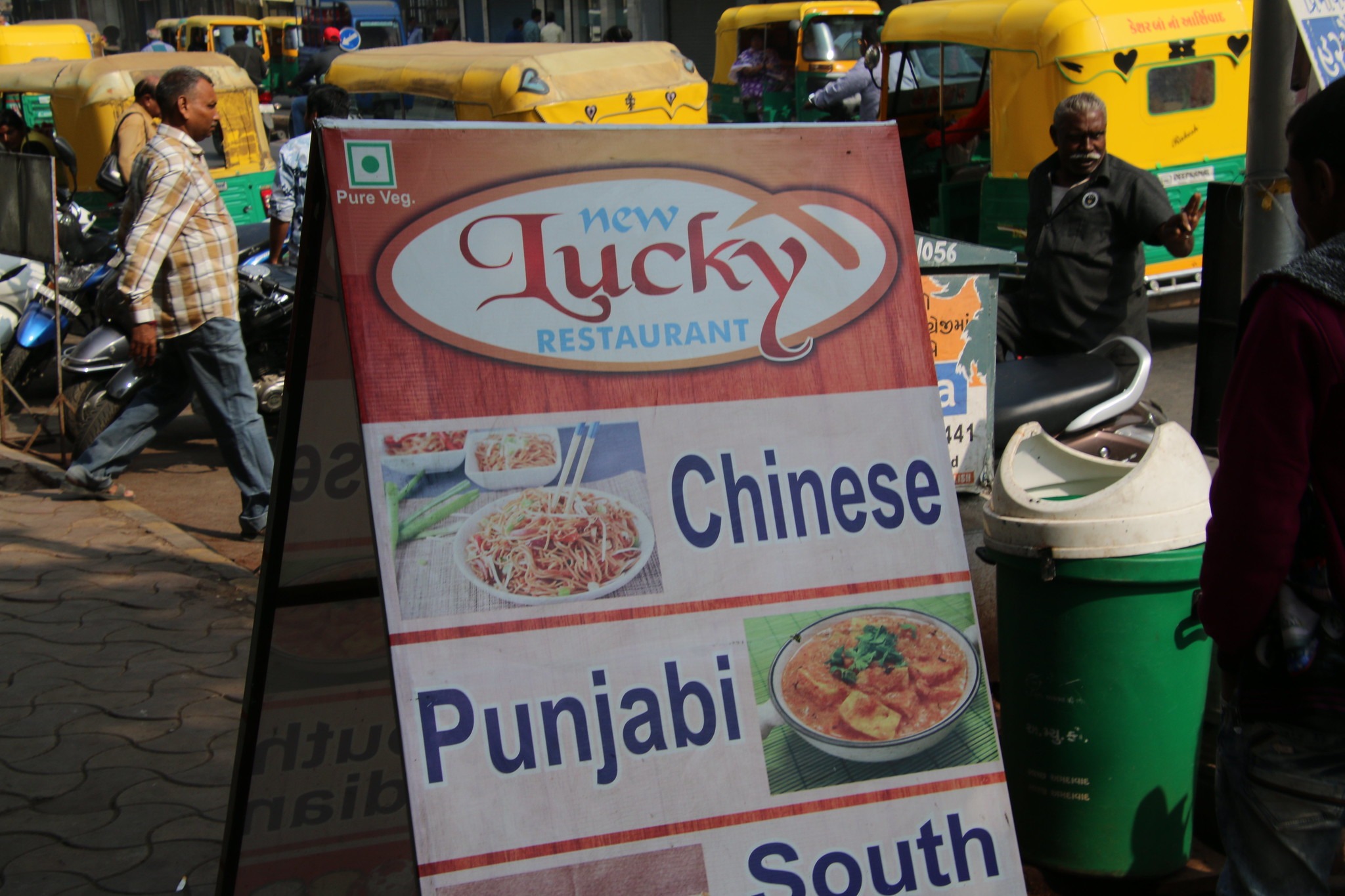
“Chinese” specialities are often clubbed together with popular regional Indian cuisines in restaurants and food stalls (Picture Credit: Corey Seeman)
So, what is Chindian food, exactly? The origins of this cuisine are in Calcutta, of course, where the entrepreneurial Chinese community opened restaurants and stalls that also catered to the Indian preferences for spice, while still being different enough to be interesting. Until the 70s, most chefs also drew inspiration from the highly successful staples of American-Chinese restaurants, including dishes like bright red American chop suey (crispy noodles served with a sweet ketchupy gravy and topped with a sunny side-up egg), chicken sweetcorn soup (an eggdrop soup thickened with cornstarch), and chow mein (stir-fried noodles usually packed with onion, garlic, and capsicum). Indian patrons could ramp up the flavor to their liking with standard condiments like green chillies floating in vinegar, soy sauce, and a red chilli-garlic chutney.
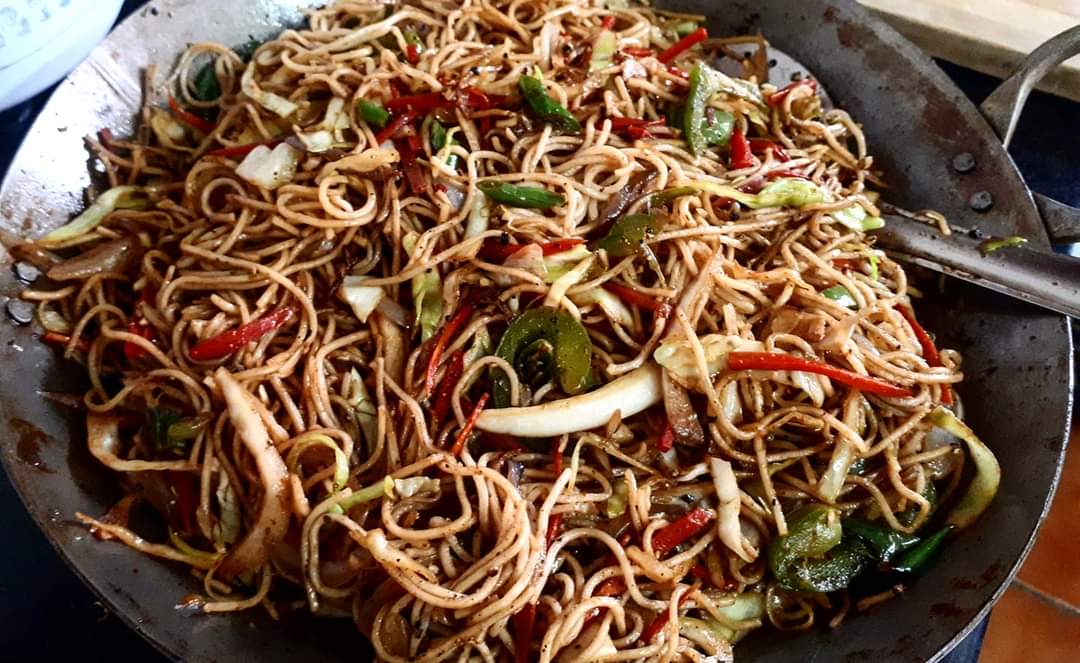
A platter of street-style vegetable chow mein with lashings of soy sauce (Picture Credit: Anamika Bajpai)
The cuisine evolved further in the 1970s when the Golden Dragon restaurant opened in the grand Taj Hotel in Mumbai, and recruited chefs from Hong Kong who introduced well-heeled Indians to the joys of “exotic” ingredients like Sichuan peppercorns. The fiery food appealed tremendously to heat-loving Indians, but they didn’t care so much for the hole burning through their pockets. The journalist and informal food historian Vir Sanghvi, who has written extensively about the evolution of Indo-Chinese cuisine, claimed the demand for Sichuan-style food in humbler eateries, “horrified the local Chinese who had forgotten where Sichuan was and had certainly never eaten this kind of food before.” Besides, they did not have the resources to access authentic ingredients. Thus began their spectacularly successful experiment in combining Indian spices and chillies (dried and/or fresh) with the usual cornstarch-soy sauce-vinegar-MSG formula. This iteration of Indo-Chinese cuisine was heavy on unctuous curry-like gravies, crisp-fried vegetables and chicken, and oodles of garlic and ginger. According to Sanghvi, the Indo-Chinese restauranteur Nelson Wang, credited with inventing the wildly popular Chicken Manchurian (deep fried chicken balls tossed in a tomato-soy gravy, and now also available in umpteen vegetarian forms) once joked to him that if Chairman Mao had been served the dish, he’d have immediately issued execution orders because of how culinarily heretical this dish was.
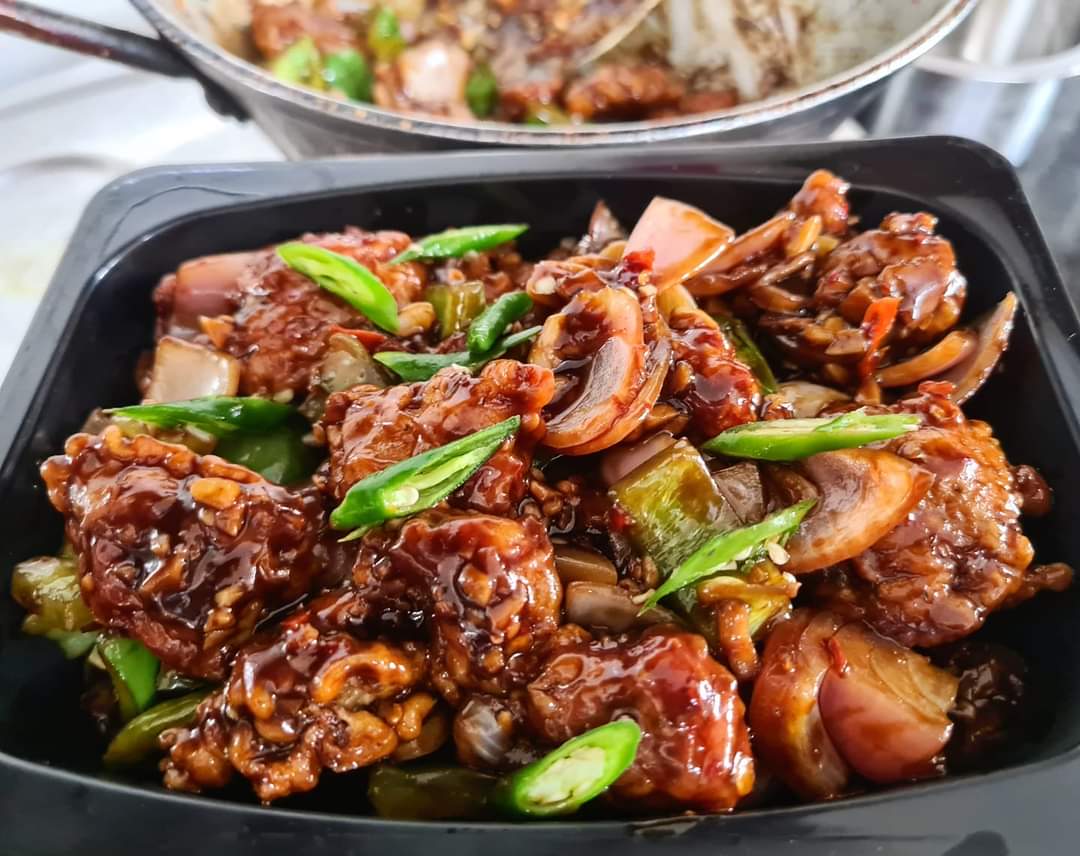
Chilli-chicken dry is a popular appetizer that lives up to its name. Those who consume it as a main dish usually order a “gravy” version that they douse over their fried rice or noodles. For vegetarians, this dish is cooked with cottage cheese cubes or mushrooms instead of chicken. (Picture Credit: Anamika Bajpai)
These developments levelled the playing field and opened up space for regional experimentation. It was clear that there was no need for Chinese chefs with any kind of special training. Adaptations could be easily made based on local ingredients and tastes — including vegetarianism and a preference for meats that don’t look disturbingly fleshy. Marriages of Chindian delights could also be happily arranged with different regional Indian cuisines. For instance, the Punjabi-Chinese (“Chinjabi”) cuisine of North India grew to be quite distinct from the original Calcutta variety. Priyanka Talreja, a food enthusiast and blogger who grew up in Calcutta but now lives in the North Indian city of Gurgaon explained: “North Indian Chinese has three to four gravies — chilli, Schezwan [the Indian red chilli-heavy take on Sichuan flavors], hot garlic, sweet-and-sour, and Manchurian. These items are a good balance generally of spicy, sour, and sweet. In Calcutta, the food is more robust and loaded with MSG. The menu will read differently too. You’ll find chilli/lemon/honey/garlic/ginger chicken but never Schezwan — and when they do try their hand at Chinjabi, it’s not normally very good.”
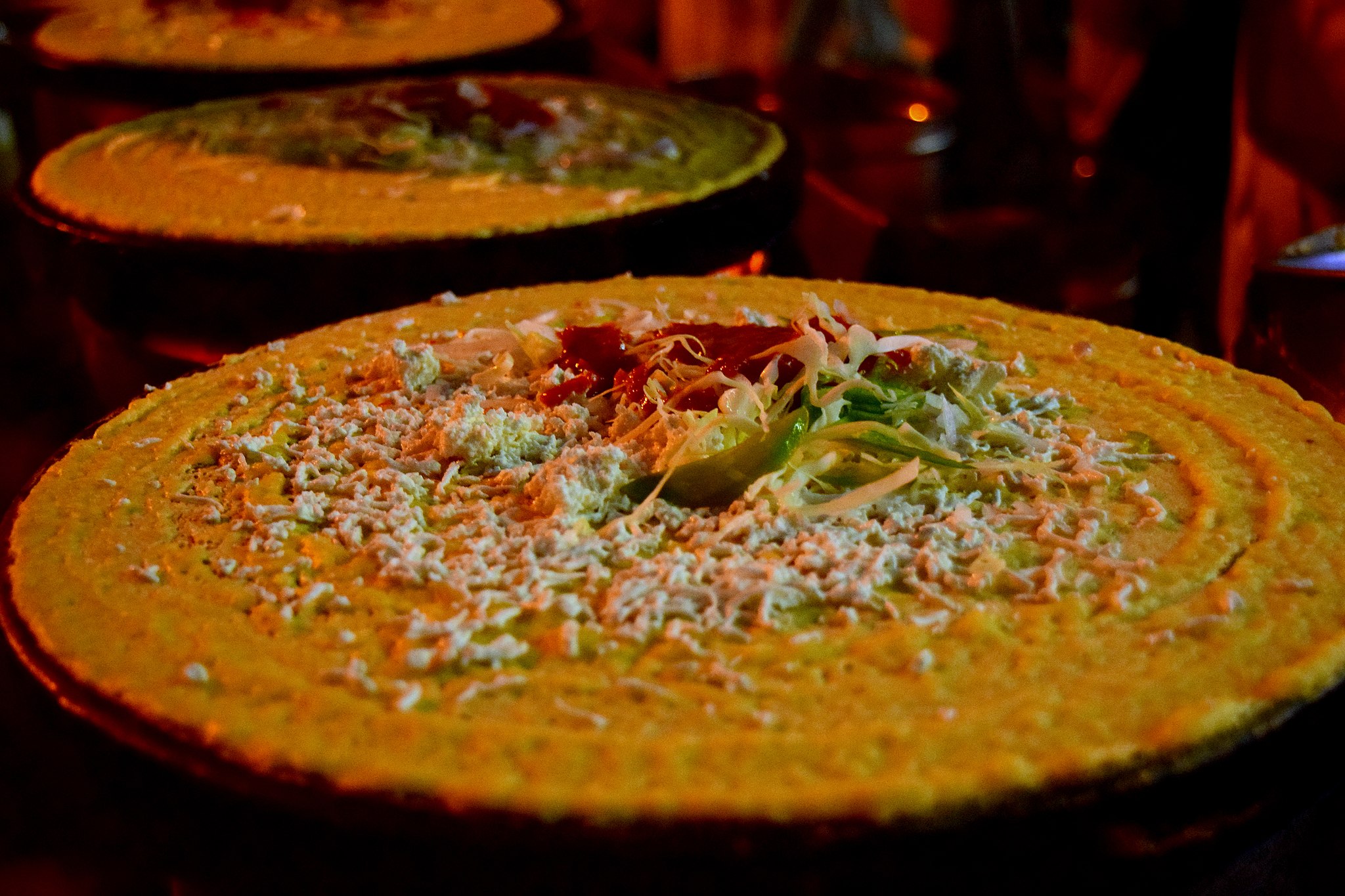
“Spring dosa” — a take on spring rolls — consists of a traditional South Indian pancake stuffed with crunchy cabbage, capsicum, and spring onions. Red chili-garlic sauce is essential. (Picture Credit: Kaushik AP)
Other more modern spinoffs include the Schezwan dosa (crisp South Indian-style rice-and-lentil pancakes slathered with a chilli-garlic sauce and occasionally stuffed with noodles), Chinese bhel (a Chindian take on a Western Indian streetside staple of puffed rice, onions, and chutneys), and the somewhat unholy tandoori momo (stuffed dumplings that are covered in a spicy marinade containing cumin, coriander, cloves, among other things — and then baked in a tandoor or oven).
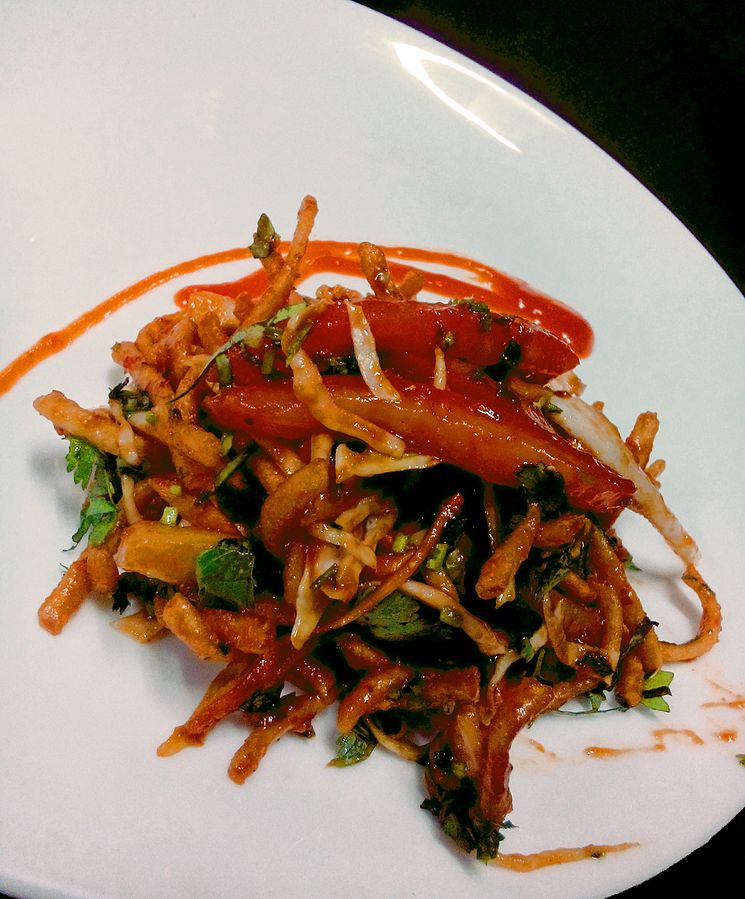
Chinese bhel features crunchy noodles and a sweet chilli sauce (instead of the traditional puffed rice and tamarind chutney), with a garnish of coriander leaves (Picture Credit: Harshmander Rastogi)
From the early 2000s, Chindian cuisine has not just grown in popularity but also in its “legitimacy,” via its appearance in cookbooks, recipe websites, and its representation in brands of packaged sauces and spices. Chindian restaurant chains celebrate their inauthenticity and their separate status from “real” Chinese food with their tongue-in-cheek (and problematic) names like Ah So Yum, Wai Yu Mun Ching, and Pa Pa Ya. Indians often boast that there is nothing really Manchurian about our Manchurian gravy, nothing Schezwan about our Schezwan sauce, and no more than a smidge of Hakka influence in our Hakka noodles. This, of course, is not quite true. Chindian food does incorporate some signature aspects of Chinese cuisine (including American-style specialities like Kung Pao chicken and chop suey that arrived here decades ago) even if these are occasionally transformed beyond recognition or combined with local ingredients. Its genesis is firmly rooted in the inventiveness of India’s Chinese community. Whatever their politics, so beloved is Chindian cuisine that many Indians are willing to engage in logical flips just to establish that it is Indian, and Indian alone — so that they can be patriots and consumers of Chindian food at the same time.
